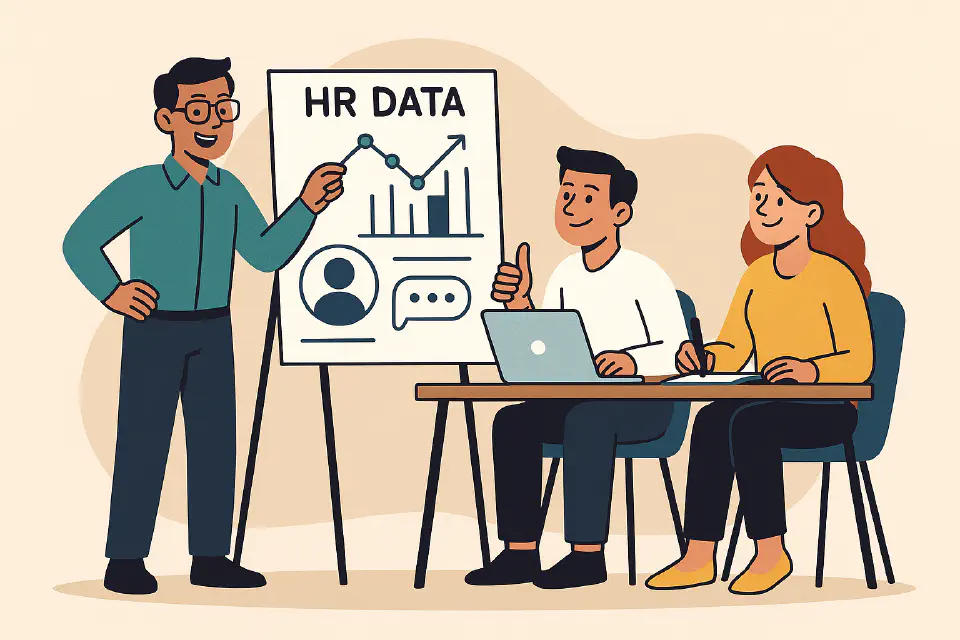
HR as a Data Translator
In a world driven by data, HR plays a critical role in making people insights understandable, actionable, and impactful. This page explores how HR becomes a translator between data and strategy — turning metrics into meaningful decisions.
Why Data Needs a Translator
Data alone doesn’t drive decisions. It only becomes powerful when someone gives it meaning. In HR, that someone is often a data translator — a professional who understands both people and the business, and can interpret patterns, trends, and risks in a way that supports action.
Without this translation, HR data remains:
- Misunderstood
- Underused
- Ignored in key strategic decisions
This role is about bridging the gap between analysts and executives, between raw metrics and human decisions.
What Data Translation Really Means
Being a translator is not the same as being a data scientist. The HR data translator:
- Understands context (business goals, culture, change)
- Interprets trends (attrition, engagement, skills gaps)
- Frames stories (why it matters, what’s at stake)
- Guides action (so what? now what?)
Translation adds narrative, relevance, and urgency to data — without it, even accurate dashboards become background noise.

Where HR Acts as a Translator
| Area of Practice | Common Data Used | Example Translation |
|---|---|---|
| Turnover & Retention | Attrition rates, exit surveys, tenure | “We’re losing mid-level women in tech at 2× the rate of others — here’s why.” |
| Engagement & Culture | eNPS, pulse survey, open-text analysis | “Trust in leadership dropped after Q2 restructuring — this may impact loyalty.” |
| DEI | Representation, hiring conversion, pay gaps | “We see high application diversity but drop-off during final interviews.” |
| Talent & Succession | Bench strength, 9-box, skills assessments | “We have no ready successor for 3 critical roles — this is a risk area.” |
| Performance | Goal completion, ratings, feedback quality | “Our feedback culture is weak — 60% of employees get no feedback at all.” |
Tools and Techniques of Translation
Translating data into action requires:
🔹 Framing the Right Questions
Before even pulling data, the HR translator clarifies:
- What are we trying to solve?
- Who needs to make a decision?
- What will influence them?
This avoids the “data dump” problem — overwhelming stakeholders with charts they don’t need.
🔹 Choosing the Right Metrics
Data translation isn’t about more data. It’s about the right data.
- Is it actionable?
- Is it credible?
- Is it relevant to current priorities?
For example, knowing your voluntary turnover rate is 12% is less useful than knowing that 60% of those leaving cite lack of growth — and 40% left within their first year.
🔹 Storytelling With Data
Good data storytelling includes:
- Narrative: What’s happening?
- Evidence: What supports it?
- Implication: Why it matters?
- Action: What should we do?
🔹 Tailoring to the Audience
The CFO doesn’t need the same data as the Head of Marketing.
- Tailor visuals, language, and context to what matters for them
- Speak in terms of cost, risk, opportunity, brand, or performance
Translation means knowing your audience — and framing accordingly.
🔹 Using Visuals Wisely
Great data translators don’t just show charts. They:
- Annotate insights
- Use comparisons and trends
- Highlight risks and opportunities visually
Tools like dashboards (e.g. Power BI, Tableau), scorecards, and infographic summaries help make insights stick.
Case Studies: Data Translation in Practice
Case 1: Predicting Attrition Risk in a Sales Organization
HR analytics flagged a 25% higher attrition rate in one region. The data translator combined turnover data with engagement survey results and manager feedback. The insight: burnout from unrealistic targets and travel overload.
Action: Regional adjustments to targets, new travel policies, and manager coaching. Attrition dropped by 18% within 6 months.
Case 2: Fixing Diversity Drop-Off in Tech Hiring
Diversity metrics showed strong application rates from underrepresented groups, but few reached final interviews. The HR translator partnered with TA and Hiring Managers to analyze interview scorecards and panel diversity.
Result: Bias-awareness training, restructured interview guides, and more diverse interviewers led to a 32% improvement in conversion rates.
Case 3: Linking Engagement to Performance Gaps
Survey data revealed low trust in leadership in two business units. HR translated this into performance risk and tied it to declining NPS and revenue.
Action: Leadership visibility efforts, transparent communications, and dedicated manager forums. Within a year, NPS rebounded and exit interviews cited better alignment.
Common Challenges and How to Overcome Them
🚫 Data Overload
Problem: Too many dashboards, too little clarity. Solution: Focus on 3–5 key insights. Prioritize storytelling over reporting.
🚫 Lack of Trust in Data
Problem: Stakeholders doubt HR data quality. Solution: Validate metrics. Explain methodology. Partner with Finance or BI.
🚫 Resistance to Insights
Problem: Leaders don’t act on what the data shows. Solution: Frame in their language. Tie to performance, cost, or risk.
Strategic Impact of HR Data Translation
When HR translates data effectively:
- Workforce risks are surfaced earlier
- Business decisions reflect people impact
- Strategy is guided by fact, not gut
It elevates HR’s role from reactive to strategic.
| Area | Value Created |
|---|---|
| Talent Strategy | Predicts future needs and gaps |
| Leadership Development | Targets readiness and effectiveness |
| Culture & Engagement | Aligns programs with lived employee experience |
| Operational Excellence | Identifies bottlenecks, absenteeism, and team health trends |
| Risk Management | Surfaces compliance and reputational risk proactively |
Competencies for HR Data Translators
| Competency | Description |
|---|---|
| Business Acumen | Knows what drives the business and how people contribute |
| Data Literacy | Can interpret, challenge, and explain metrics |
| Communication | Turns complex insights into clear, persuasive narratives |
| Collaboration | Works with Finance, Ops, Legal, and Tech teams |
| Strategic Thinking | Aligns insights with long-term goals |
Final Thought
Data doesn’t speak for itself. HR must.
By becoming translators, not just collectors, HR turns people data into strategic advantage. This role demands curiosity, credibility, and clarity — but it delivers real impact.
Because when HR translates well, the business listens.